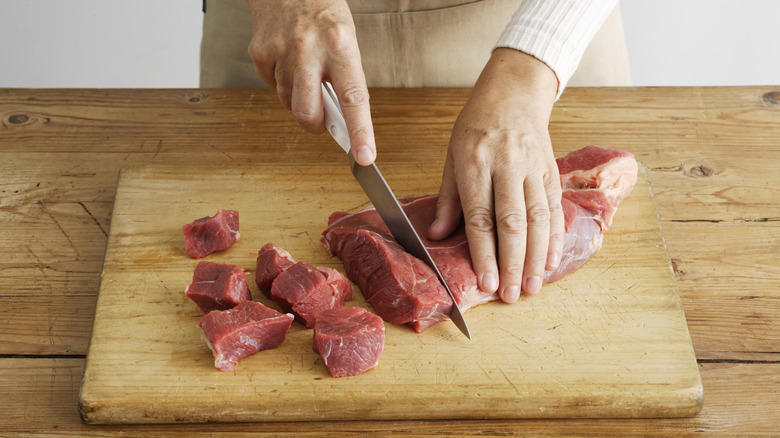The kitchen is often the heart of the home, a place where creativity flourishes and memories are made. But sometimes, this hub of joy turns into a battleground of food safety debates. One hot topic? Whether it’s necessary to clean your cutting board between slicing raw meat and cutting vegetables. Some say it’s overkill, while others argue it’s essential. Let’s dive into the science, risks, and best practices behind this everyday kitchen dilemma.
Understanding the Dangers of Cross-Contamination

Cross-contamination is a silent threat in the kitchen. It occurs when harmful bacteria transfer from one surface or food to another, potentially leading to foodborne illnesses. Cutting raw meat on a board can leave behind pathogens like Salmonella, E. coli, and Campylobacter. If you then chop vegetables or other ready-to-eat foods on the same board without cleaning it, you risk contaminating them.
Why is this such a big deal? These pathogens can cause severe illnesses, and even small traces left behind on a cutting board can pose a danger. The consequences aren’t just hypothetical—cases of foodborne illnesses linked to cross-contamination are well-documented.
The Science Behind Foodborne Illnesses
Foodborne illnesses occur when you consume food contaminated with bacteria, viruses, or toxins. Symptoms can range from mild discomfort to severe complications, including hospitalization. The bacteria found in raw meat can survive on surfaces like cutting boards for extended periods if not properly cleaned.
For instance, studies show that some bacteria can remain active for hours or even days, making thorough cleaning a non-negotiable step. By washing your cutting board, you interrupt the contamination cycle, safeguarding your health and that of your family.
Best Practices for Cutting Board Hygiene
If you want to keep your kitchen safe, adopting smart hygiene practices is key. Here are the best ways to maintain cutting board cleanliness:
- Use Separate Boards: Dedicate one board for raw meat and another for vegetables or ready-to-eat foods. This simple step can eliminate the risk of cross-contamination.
- Wash with Hot, Soapy Water: After using a cutting board for raw meat, scrub it thoroughly with hot, soapy water. Pay attention to all grooves and edges.
- Sanitize Regularly: Disinfect cutting boards using a solution of one tablespoon of unscented bleach per gallon of water. Let it air dry completely to prevent bacteria growth.
- Inspect for Damage: Cutting boards can develop grooves and cracks where bacteria can hide. Replace boards that are heavily worn or damaged.
These practices are straightforward but highly effective in reducing food safety risks.
What Experts Say About Cutting Board Cleaning
Leading health organizations, including the Centers for Disease Control and Prevention (CDC) and the Food and Drug Administration (FDA), strongly advocate for cleaning cutting boards between uses. Their guidelines are grounded in scientific evidence and emphasize the critical role of hygiene in preventing foodborne illnesses.
These recommendations might seem excessive to some, but they’re not about being paranoid—they’re about protecting yourself and others from potentially serious health issues.
Dispelling Common Myths About Cutting Board Hygiene

Misconceptions about cutting board cleaning can lead to unsafe practices. Let’s set the record straight:
- “A Quick Rinse is Enough”: Rinsing a cutting board with water won’t kill bacteria. Only thorough cleaning with soap and hot water can do the job.
- “Wooden Boards Are Unsafe”: While wooden boards can absorb bacteria, they also have natural antimicrobial properties. Proper cleaning and drying make them as safe as other materials.
- “Plastic Boards Are Always Better”: Plastic boards are easy to clean, but they can develop deep grooves where bacteria hide. Regular sanitizing is crucial for keeping them safe.
Choosing the Best Cutting Board for Your Needs
The material of your cutting board plays a significant role in hygiene and durability. Here’s a quick guide to the most common types:
- Wooden Boards: Durable and naturally antimicrobial, wooden boards require extra care, including thorough drying after washing.
- Plastic Boards: Practical and easy to sanitize, but prone to deep grooves over time. Replace them when they become excessively worn.
- Bamboo Boards: Eco-friendly and resistant to knife scars, bamboo boards are a great option but may require regular oiling to prevent cracking.
No matter which type you choose, proper cleaning and maintenance are non-negotiable.
Simple Tips for Safe Food Preparation

A clean cutting board is just one piece of the puzzle. To ensure overall kitchen safety, follow these additional tips:
- Wash Your Hands: Always wash your hands before and after handling raw meat.
- Use Separate Utensils: Keep knives and other tools used for raw meat separate from those for other foods.
- Sanitize Surfaces: Regularly disinfect countertops and other food prep areas.
- Store Food Properly: Keep raw meat in sealed containers to avoid drips and contamination.
- When in Doubt, Clean It: If you’re unsure whether a cutting board or utensil is clean, take the time to wash it.
Why Cleaning Your Cutting Board is Worth It
Some might argue that cleaning a cutting board between uses is excessive, but the stakes are too high to take shortcuts. Foodborne illnesses can be particularly dangerous for children, the elderly, and individuals with weakened immune systems. Spending a few extra minutes cleaning your cutting board is a small price to pay for peace of mind.
Conclusion: Kitchen Safety Starts with You
At the end of the day, maintaining cutting board hygiene is a simple yet powerful way to protect yourself and your loved ones from foodborne illnesses. The science is clear, and the experts agree: cleaning your cutting board between cutting raw meat and vegetables isn’t overkill—it’s a basic safety measure.
By following best practices like using separate boards, washing with hot soapy water, and regularly sanitizing, you can enjoy cooking with confidence. After all, isn’t a healthy kitchen worth a little extra effort?


